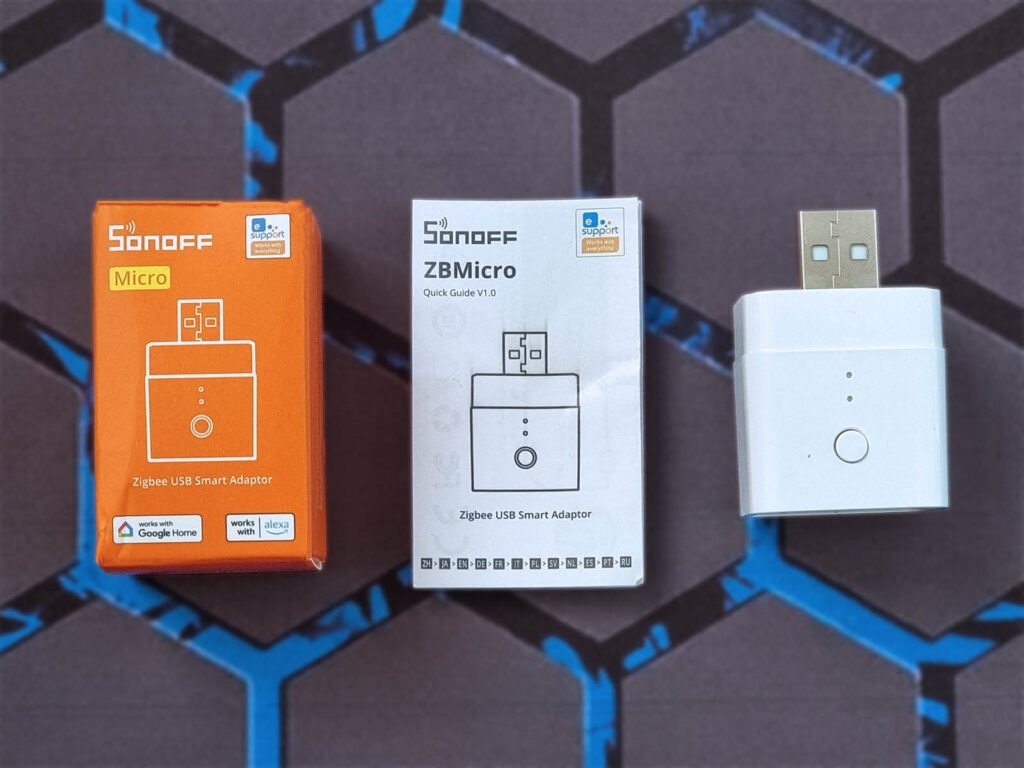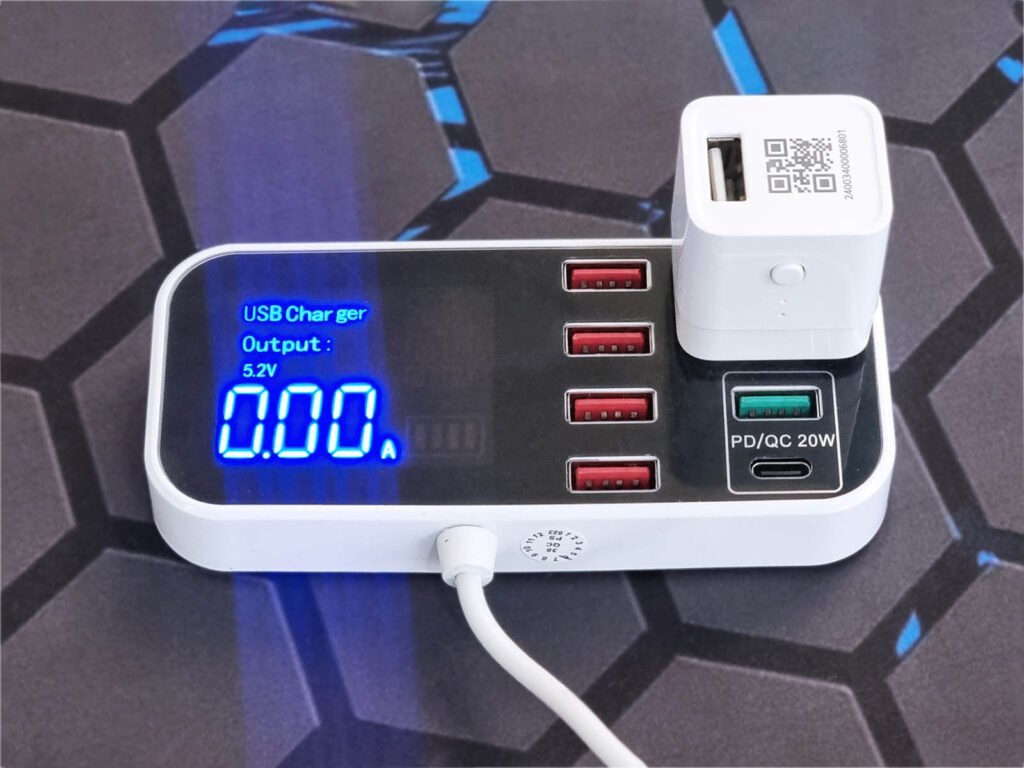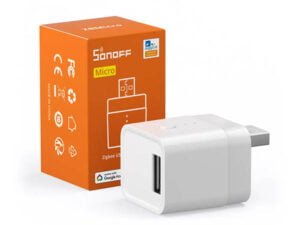The ZBMicro is a new type of smart switch from Sonoff. Instead of controlling large appliances operating at 110-220V AC, it’s meant to control any USB device at 5V. It’s a very small and compact USB adapter, with quite a versatile use case within a smart home.

In this article, I’m taking a look at the Sonoff ZBMicro’s feature set, build quality and Home Assistant integration. This USB smart adapter costs $12.90 and is available on their Official Store, AliExpress and Amazon.
Technical Specification
- Model: Sonoff ZBMicro
- Connectivity: Zigbee 3.0
- Interface: USB Type-A
- Power Rating: 5-22V ~ 4.6A MAX
- Max Output: 36W (With QC 3.0 Adapter)
- Operating Temperature: -10°C to 40°C
- Operating Humidity: 5-95% RH, non-condensing
- Dimensions: 33x31x26.5mm
- Supports: QC 3.0, FCP, SCP, PE, AFC, Apple 2.4A
Package Contents and Teardown
The Sonoff ZBMicro USB Adapter ships in a tiny company branded box, containing the device itself and a user manual. Since I ordered my sample from AliExpress, box got banged up during shipping as usual. The device was intact and operated as it should.

The Sonoff ZBMicro is a very small USB adapter, much smaller than anything else I had on hand. It’s designed to fit power bricks and existing adapters without protruding too much or covering adjacent USB ports.
It feels very lightweight when handled, yet sturdy and compact. There’s a small control and pairing button in the middle along with two small indicator LEDs installed underneath.

Underneath the USB plug, some basic information about the device is printed. On the other side, the USB Type-A port is located along with a QR pairing code. This code takes you to their proprietary eWelink app, so no need to bother and scan it.


The top lid of the ZBMicro was glued shut and I had to pry it open with the metal pry tool from my Kaiweets set. Once I did, a very simple PCB is revealed, holding both the male and female USB ports, a voltage converter and the Zigbee communications module.

The Sonoff ZBMicro uses the EFR32MG21 [Datasheet] for it’s Zigbee connectivity. This is one of the latest Zigbee/Thread SoCs found in many coordinators like the Sonoff ZBDongle-E, SMLight SLZB-06M or the Home Assistant Connect ZBT-1.
The voltage step-down converted used is the JoulWatt JW5015A [Datasheet], operating at 5-40V with a 2A current output.

Home Assistant Integration
The Sonoff ZBMicro is supported out of the box in both ZHA and Zigbee2MQTT. To pair it to your coordinator, you need to hold the button for ~5 sec until the indicator LED starts blinking in orange/red color.
Zigbee2MQTT

Once paired to Zigbee2MQTT, the Sonoff ZBMicro is correctly identified as a Router by manufacturer Sonoff and Zigbee Model ZBMicro. The device also supports OTA updates, with the current version of my sample being 1.0.4.
It exposes the following entities in Home Assistant through Zigbee2MQTT:

The State is a simple on/off toggle switch, whose power-on behavior can be set to on, off, toggle and previous. The ZBMicro also has a built-in inching control mode, which allows you to change the state automatically after a preset time.
What’s interesting here is the availability of an RF turbo mode feature.
To meet the radio certification standards of some countries, the standard factory settings reduce transmission power to a relatively low range. This results in smaller signal coverage and minimizes interference with other equipment, ensuring compliance with global radio regulations.
When you manually turn on Turbo mode, the radio power is adjusted to the maximum, extending the signal’s transmission and coverage to its full potential. However, in some countries and regions, this RF signal strength may exceed legal requirements, even though it is usually unnoticeable.
Turning on Turbo mode has no effect on the lifespan or operation mode of the device.
ZHA

The Sonoff ZBMicro is also supported in ZHA out of the box, although some of it’s features are missing. You are able to control the device and change the power-on behavior. Inching mode, as well as RF turbo mode are unavailable, which I fully expected from ZHA.
Usability and performance
I’ve been using the Sonoff ZBMicro in my office for almost a week now, and I’ve gotten a good sense of it’s capability and usability. I’ve used it with a phone charger, as a power supply switch for presence sensors, and as a simple smart switch for several PC peripherals (speakers, desk lamp).
The primary use case of the ZBMicro is advertised as being a smart phone charger. Basically, it cuts power whenever your battery reaches 100% and resumes charging after it drops bellow a certain percentage. Okay, that’s great, but I don’t really see the utility in this, especially considering moderns smartphones do this by default.

It’s worth mentioning that the ZBMicro also supports data transfer with USB 2.0 speeds. For example, you can use the device to schedule backups of sensitive information to a storage media, cutting power and detaching the disk when it’s not in use. Good for safe-keeping and as an added security measure.
Zigbee communication was perfectly solid and robust. I run a test network in the office centered around the SLZB-06p7 PoE coordinator and did not encounter any delays, drops or lags. The biggest use case for me is the fact that the Sonoff ZBMicro is a dedicated Zigbee router. It will form paths to the coordinator from adjacent devices, healing and solidifying your Zigbee mesh network.
I’ve talked about the importance of Zigbee repeaters on several occasions, and the ZBMicro fills this gap perfectly. The added bonus here is that you also get a smart switch for whatever you’ve connected to the ZBMicro.
One feature I would have loved to see in the ZBMicro is an integrated energy meter. I’ve never measured the power consumption of low-power devices, and the ZBMicro would have been a perfect device for the job.
Final Thoughts
The Sonoff ZBMicro is perhaps the only device that had no surprises for me, one way or the other. It does what is says and it operates the way it should. I would buy the ZBMicro solely for it’s well-rounded Zigbee routing function.
If you are looking for an USB smart switch, look no further, as the ZBMicro is well supported and has a very affordable price. Here are some links from different stores:

![]()
AliExpress | AliExpress | AliExpress![]()
United States | Germany | Netherlands
Sweden | Spain | France | Italy
ITEAD OFFICIAL STORE
*If links fail to open, try disabling your AdBlocker.
ads










It would be great to have USB-C variant to fit modern chargers.
Another thing: Ability to ping over BLE to phone can send “Please stop charging me” and “Please chage me” without ZB network. (Use case: Phone app to float battery charger in 50-60% range or any other user-set spread)
With Tuya WiFi versions of this around forever, I’m surprised it took that long to happen. Seems handy for making simple USB lights turn off, or automating rebooting network device. Sadly won’t work on USB lights that need a button pressed to turn on.
Did you check how much power it passed through? All of it, including QC3.0?
Would love a USB-C version, but that would be more complicated for power.
Do you have Infos about the power consumption / standby use?
It consumes about 0.3-0.5W when idle.
Which is around 2.628-4.38 kWh/year.
IMHO this is a solution in search for a problem to solve.
I can’t really think of a single feature that this has on top of what all Zigbee sockets normally offer. The major difference is that ZBMicro puts the switch after the power adapter! Oh, that that makes two devices constantly using a few hundred mW. So?
I use the wifi versions for the kids night lights which are USB powered. It’s great to turn those lights off after set time etc. I’ve been waiting for zigbee variants for some time, so I’m really interested in these.
I use it for my USB desk fan, which is the ideal size/quietness for me. No 230V equivalent and they’ve been discontinued by the manufacturer.
I use this to keep my HA tablet charged between 20-80%, don’t really feel comfortable keeping it plugged in constantly and not sure how smart the cheap chinese tablets are.
Can’t use a smart plug in my case as I am using an old 12v (old intercom) stepped down to 5v for power.
Warning, the wifi variant does not pass data